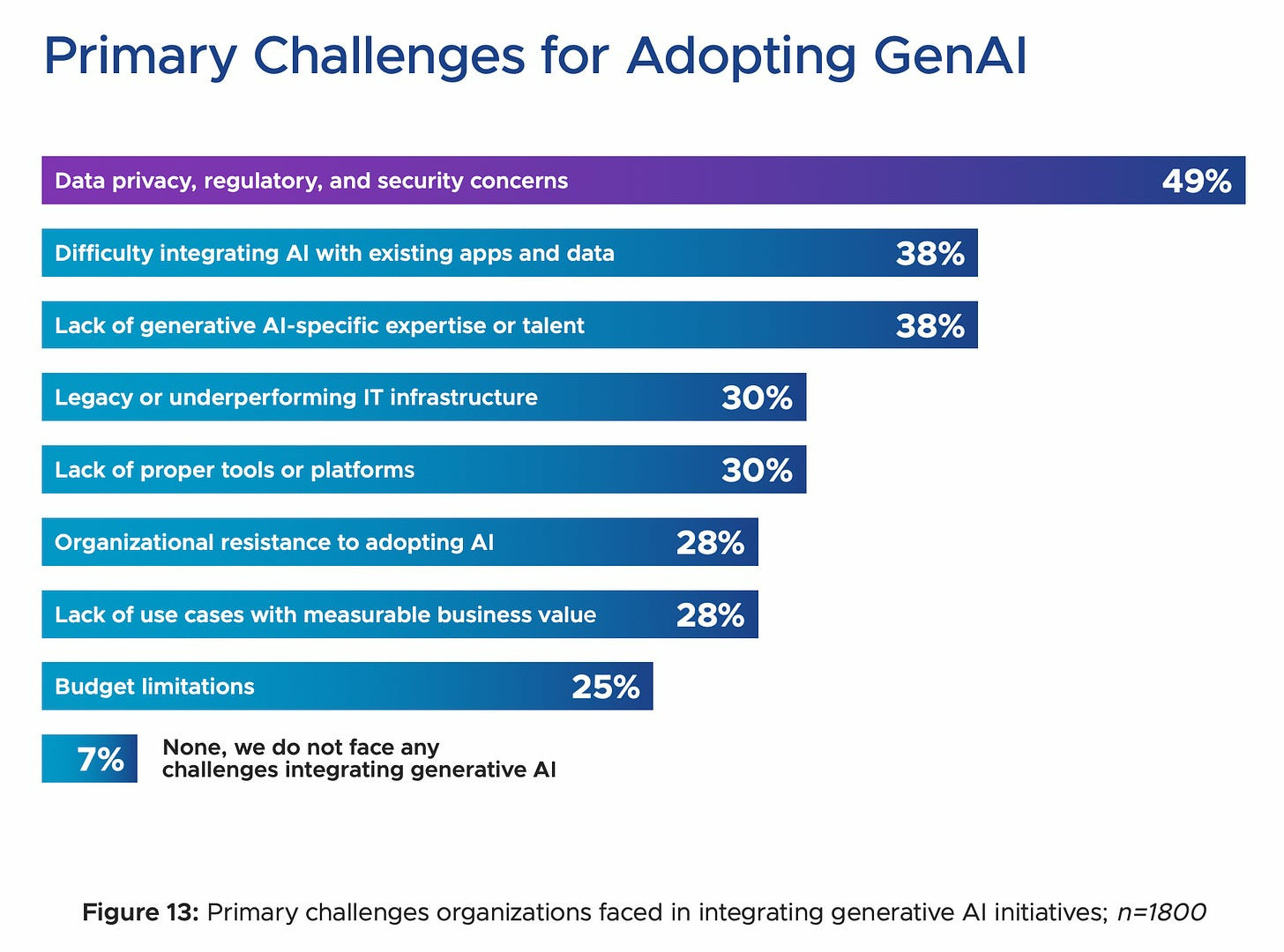Where are the workloads?
Let’s check in on how much private there is nowadays. I think it’s somewhere in the range of 40% to 60% of workloads1 globally. If you narrow down to “enterprises” (let’s say organization that have 5,000, even 10,000 employees), my sense is that the number goes way up, maybe 70%.
The way I think about the question “how much private cloud is there?” is “where are all the applications and services running.” I think most people think of that question in terms of revenue, market-share - a way of thinking that my 401(k) is way into as a sense-making tool, but doesn’t reflect how people should make strategic choices in IT.
And, yes, I’m obviously biased, swimming around in big, C.R.E.A.M-y pools of WYSIATI. I work at a company that is focused on building and selling private PaaS. That’s why I spend so much time gathering charts and anecdata on private cloud.
Oh, also, if you want a PaaS - or, “platform” if you prefer - you should use ours, the Tanzu Platform. It’s proven, used by all sort of enterprises, and, you know, just works.
Back to pondering…
My last private cloud check-in was July of 2024. The conclusions haven’t changed much since then, which part of the conclusion, I guess.
Here’s the charts and analysis I currently use at the tail end of Spring 2025, plus some new items from this week.
The Charts

A chart like this has a lot of nuance. It’s the most recent IDC CloudPulse, one of the few analyst surveys/reports that asks the question “where are the workloads?” They don’t like to call it “private cloud,” and instead prefer “dedicated environment.” I assume the Q3 2028 numbers are estimates - IDC’s valuation would be a lot higher if they had a time machine.
They don’t like you using older data, which makes sense. Their methodology can change over the years. Here’s a screenshot of that represents my thinking, synthesis, and sloppy reconciling of surveys over the years:
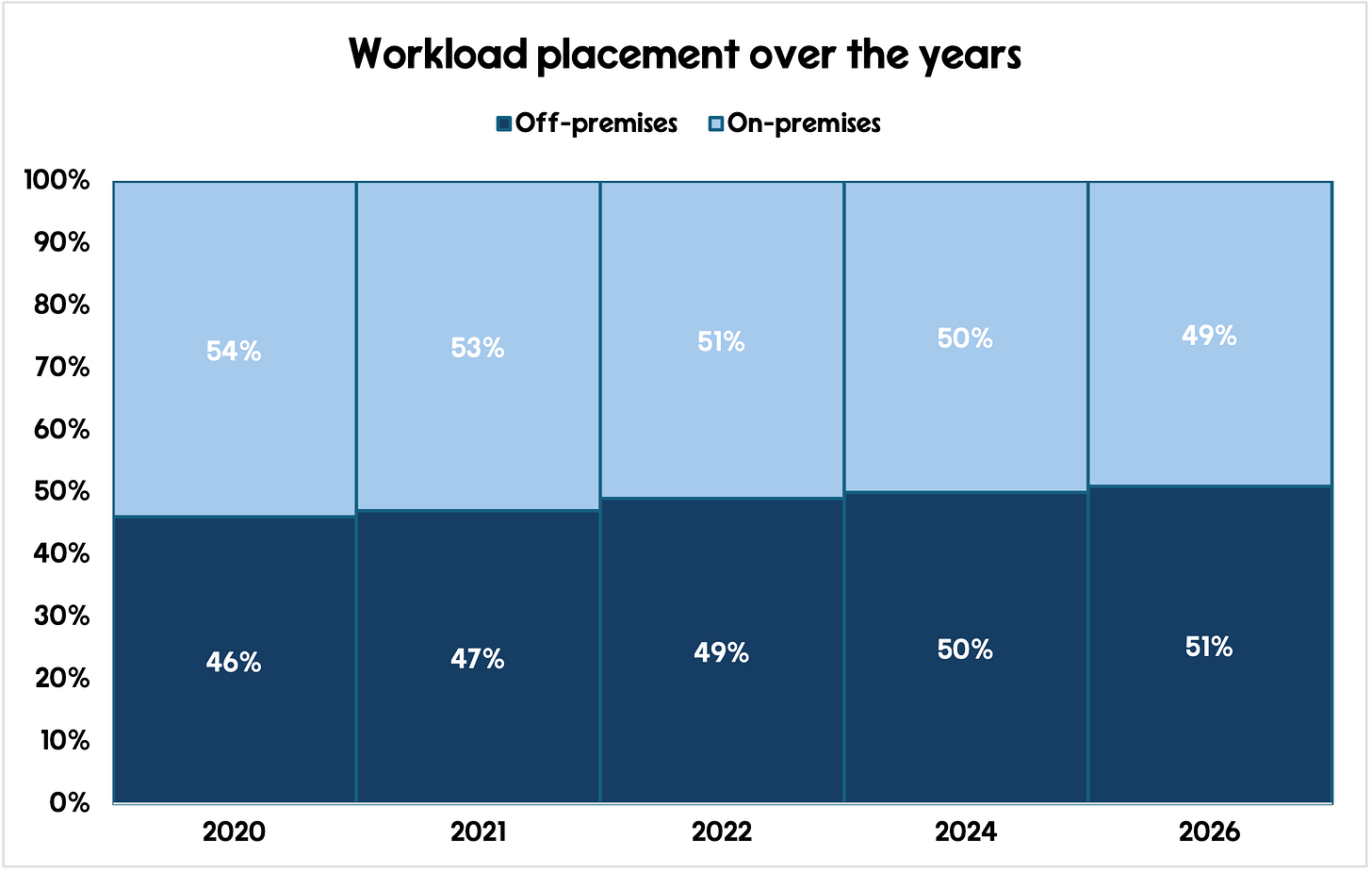
Here, you see a steady state. We could call it 50/50.
That steady state matches up with a Goldman survey of CIO’s plans for cloud migration. I haven’t found an update on this, so it’s same as last time:
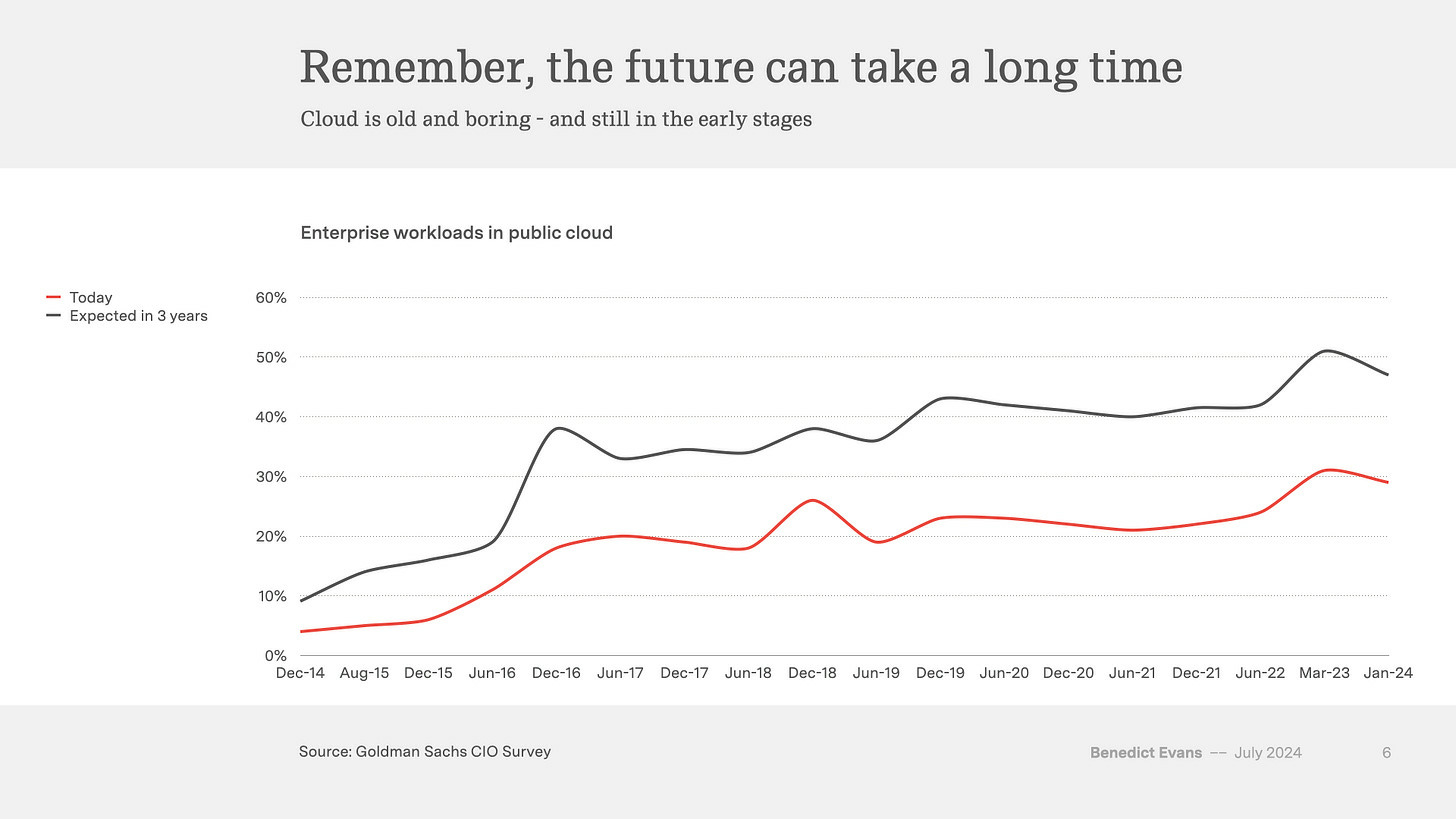
What you see in that chart is that CIOs are always going on about moving more workloads to public cloud, but they move a lot less than planned.2 The workloads stay where they are. And here, in January 2024, the % of workloads in private cloud was ~30%. That’s a lot less than the IDC numbers.
Now, I’ve tried to track down the PDFs for these surveys to understand them better, check methodology and definitions, etc., but never found them. Slides Benedict is reliable enough though, so I’ll trust he (and/or his intern) has done the work. As such, I use this chart more as vibe-check for charts than a primary ponder.
There’s a few more charts (this one in particular, and this one is pretty good too) that you should check out if you care about all this. I went over a full round-up of them at cfgmgmtcamp back in February as well.
What the ^F50*$ are up to
And then, there’s this anecdata:
[W]e do have a lot of large customers that are running in AWS in the cloud today, and a huge number of them still have massive amounts of their estate on-premise. And so there’s a huge amount of growth available there. You can even take our largest customers, many of them only have 10, 20, 30, or 40 percent of their workloads in the cloud.
I put this under anecdata because the scoping isn’t specified and you can really go all confirmation bias on it. You can read it as saying that in large enterprises, anywhere between 60% and 90% of their workloads are running on private cloud. Of course, Garman might be talking about just two customers, or 500, or 50. Who knows! (And, what about the ones that are not AWS customers?)
Also, stating numbers like is about making sure you’re building in future growth into your share price. The point of the above is saying “and we’re going to get those workloads, think of all the future revenue!” - a variation on the “your margin is my opportunity” bit.
Moving back to private cloud
And then, we have Corey Quinn, this week on cloud repatriation:
Five years ago, I fairly confidently stated that Cloud Repatriation Isn’t a Thing, and I by and large stand by what I wrote. That said, it’s 2025, and the story has changed…
He goes on to list the reasons you’d move workloads from public cloud back to private cloud: lowering costs, especially for companies that are no longer in ZiRP-growth mode and data sovereignty.
This last part is the Trump effect - despite possible TACO safe-guards, does the rest of the world (business and government) want to run their business under the jurisdiction of Trump? Just like the US tech-folk go nuts when the EU calls the shots: nope. (Sure do like that USB-C on my Apple devices tho…)
Now, you have to be careful with repatriation surveys. What you want to know is not if they are doing (or even planning) repatriation, but how many workloads they’re moving (or plan to move). There’s a big difference between repatriating one or two workloads (like DHH or, as Corey recalls, Dropbox), or hundreds.
What caught my attention in Corey’s post though was that the repatriation thought-leader’ing has reached him, and enough for him to post about it! He could be making fun of AWS, but instead he’s talking about enterprise cloud repatriation.
The relevant Barclays survey is from April 2024, was promoted by Michael Dell in the same month, and showed up at VMware Explore in August, 2024. That thought-leader’ing has legs.3
(Checking out the original PDF is worth it for other fun charts, if you’re into these kinds of things.)
March 6 to April 4, 2025 Broadcom Survey
My employer has a new survey out on the private cloud use question (here’s a direct PDF link).
First, one of the charts on reparation:
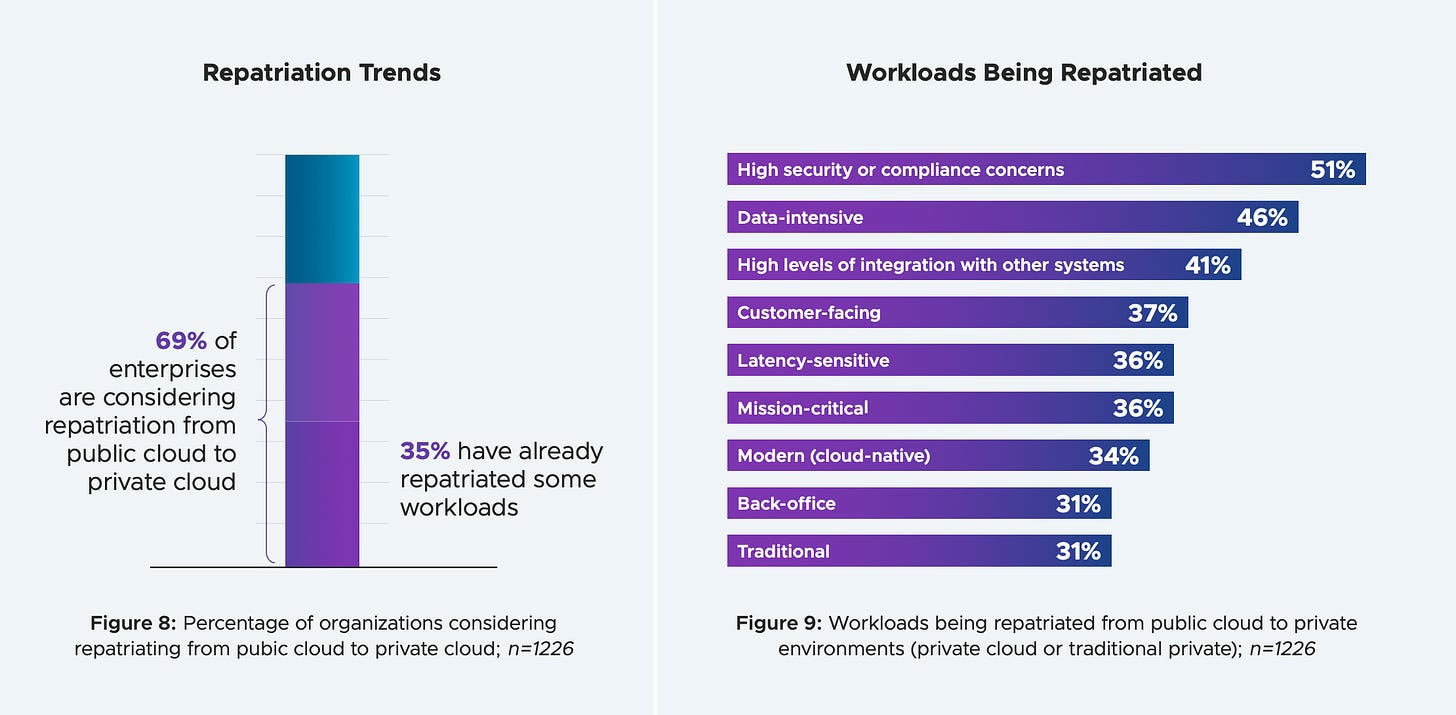
I like it when a chart breaks down into categories as seen here: what are the characteristics/needs of the workloads being moved. Security is always on-top of the list (see below), and then the next two are about working with existing enterprise apps and systems. The forth - customer facing - is important because it tells you that the apps are important for the business.
The new workloads
Now, my “where are the workloads” focus is about where the existing workloads are. From the above, it feels like the answer has been the same (40% or 50% or 60% - whatever, you get the idea) for a while.
One reason is probably “because it works fine, don't screw with it.” Another reason might be because there hasn’t really been many new app types since, maybe, the 2010’s. In those years, enterprises was freaking the fuck out about “digital” and were rushing to get better at software, driving a bunch of new apps which dragged in a bunch of new infrastructure.
The survey doesn’t address my core question (how many workloads are on private cloud versus public cloud), but it does cover sentiments and plans for app placement. For example, as Raakhee Mistry summarizes:
When asked to identify each of their top cloud priorities, the most cited 3-year priority was to build new workloads in private cloud environments (53%)… 84% of organizations are using private cloud for both traditional and modern applications.
What those workloads are isn’t specified. But, from what people are saying AI is driving a lot of new workloads. After a year of PoC’ing and puttering around with python, followed by some planning and annual budget begging in Fall 2025, 2026 might be the year where enterprises start adding AI into a lot existing apps and making new apps - we’ll see!
The survey gives us a couple of interesting bits on this AI growth workload pondering. First, what are the “challenges” for doing AI? You can reframe “challenges” as “needs” or, simply, “requirements”4:
Security is always the #1 in concern. It’s both true and virtue-signaling: “What? Nah, we’re not worried about security,” said no IT survey respondent ever.
The second bar down is more interesting. The need to integrate with existing apps and data shows that people are not thinking of net-new, stand alone application, but ways of augmenting/improving their existing apps and, thus, businesses. This is great! It means they’re looking to get better at the bulk of what they do, not just play in the margins like making videos of a crooning grizzly bears in a lounge to, presumably, sell more Instagram cuff-links.
It’s also easy to imagine that with AI we’ll encounter data gravity again. That is, all that data and existing apps and services are on the private cloud (and will stay there), so your new apps will need some way to connect with them. See the surveys above for the important of integrating with data and existing apps!
This think pairs up with the last chart I use now, one from another Broadcom/VMware sponsored report in December 2025:
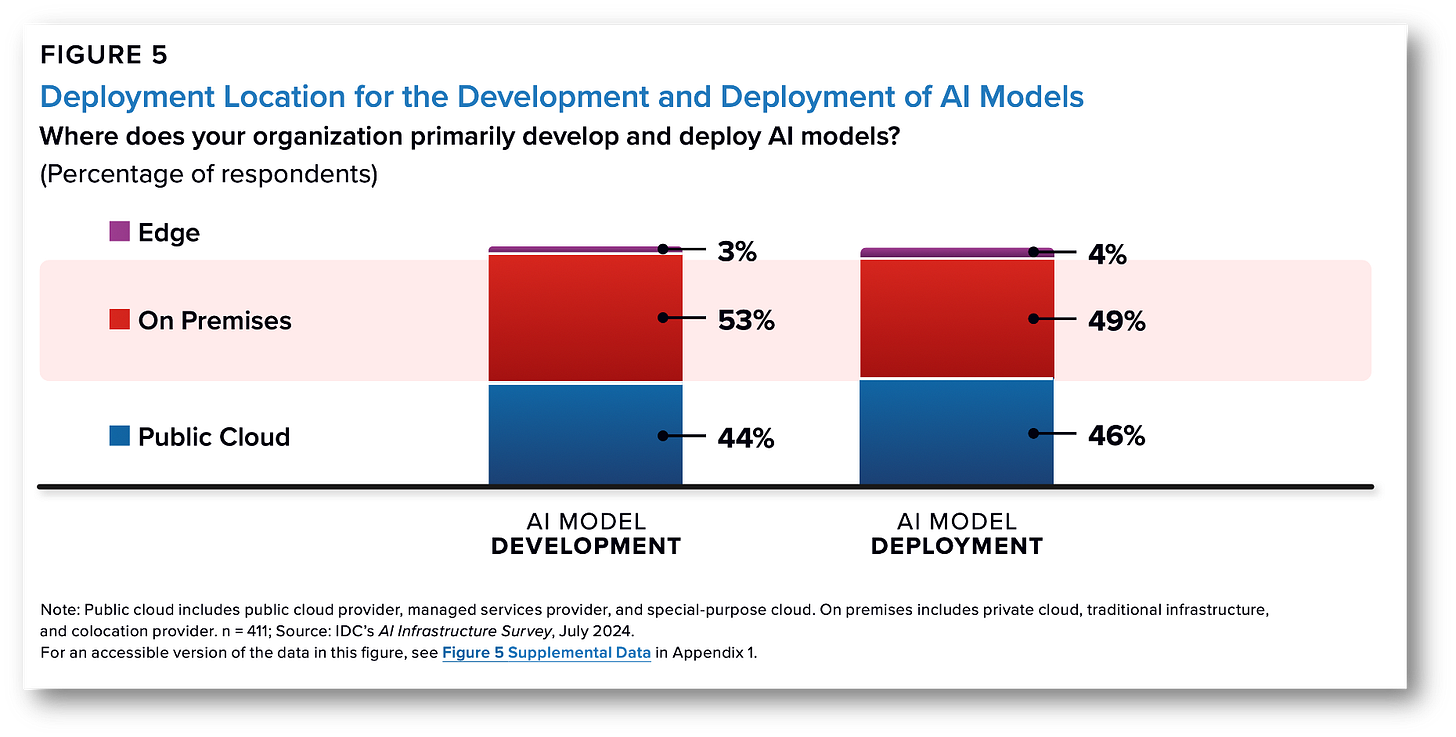
There, you can see that people are planning on deploying ~50% of their models on-premises. That’s not apps, sure, but if the model is on-premises, chances are high the apps will be there too.
The Beginning of the Last Inning
So, for many of years now, the number of workloads on private cloud seems to be holding steady. There’s a strong possibility that a new type of application, AI, will drive interest in doing a lot of new applications. For those AI apps, data and access to existing enterprise goop is needed. Some people are pondering repatriation, at least enough for Corey to skip the opportunity to take more pot-shots at Kubernetes.
It must all mean something!
I joked in that February talk that the cloud people love talking about being in the first inning of a baseball game. Based on thorough joke-analysis of these “early in the first inning” quotes over the years, I estimated that this means the public cloud baseball game will wrap either in 2027 or 2068, with 2042 being somewhere in the middle:
If the game ended now, we’d be at a 50/50 split or so, bouncing around lazily over the years. Based on things in the last days of Spring 2025, I’m guessing we’re finally further into the last inning than just barely into the first.
Logoff
That’s it for today. I have three things to self-promote, though:
My post first post in a series on writing MCP Servers for D&D. Hopefully the second will be up very soon, corporate copy editors and The New Stack CMS’ers willing.
I was super thrilled to interview Taegan Goddard on Whitney and I’s podcast. I really like his, I don’t know, blog, Political Wire and admire him as a indie publishing empire.
And, this week’s Software Defined Talk is fun, take a listen.
//
Oh, also, I asked ChatGPT to “make a picture of what you think I look like in a style you think I would I appreciate,” and it has a sort of Marc Maron if he were a hedge-wizard feel, don’t you think?
…enjoy your weekend.
Hey, The Kids, I’m sorry to be old. I use the term “workloads” to mean “stuff you run on your computers.” If it feels weird, sub-in the word “applications,” but keep in mind it should be something more like, “applications and services.”
As some of my snarkier enterprise friends like to say, cloud migrations are a 1 and half CIO job. The first CIO will launch the initiative, but leave after three years before it’s done, require the next one to spend half their time on it. Of course, it could turn into a 2 CIO job.
Here's some further commentary on the Barclays chart from Larry Walsh, August, 2024: “The problem with the 83% figure is that it represents companies, not workloads. So if 83% of enterprises decide to move one workload from the public cloud to their local infrastructure, the number remains true.”
Also, “shit that keeps the CIO up at night.”

